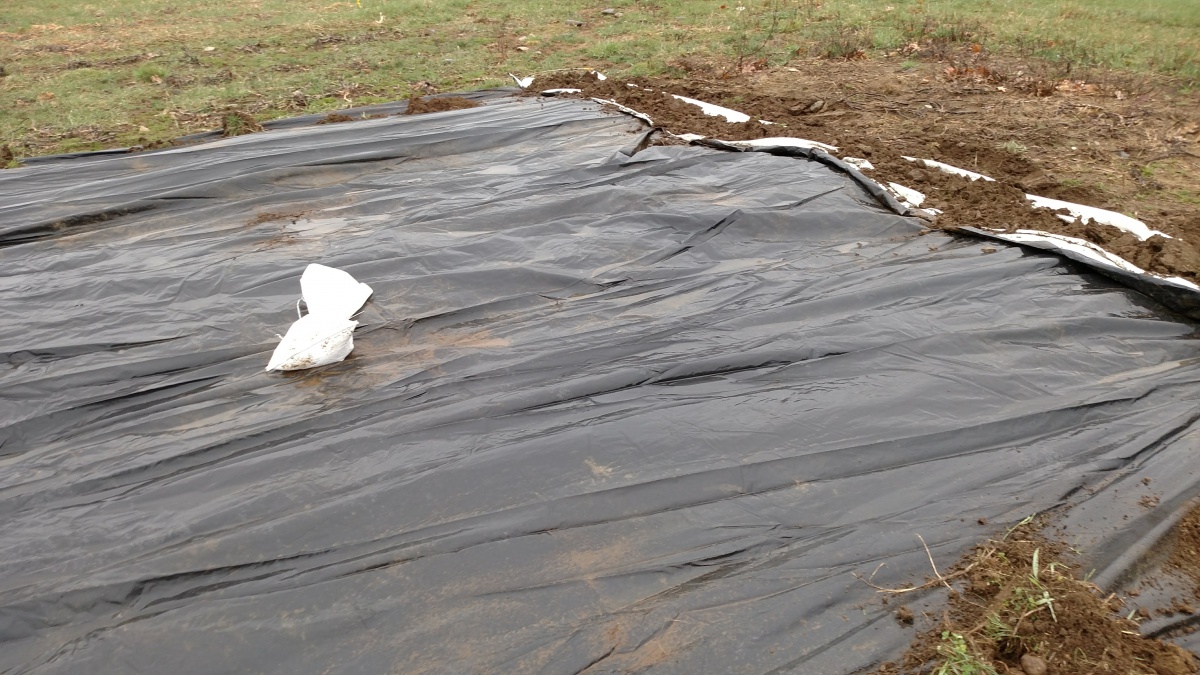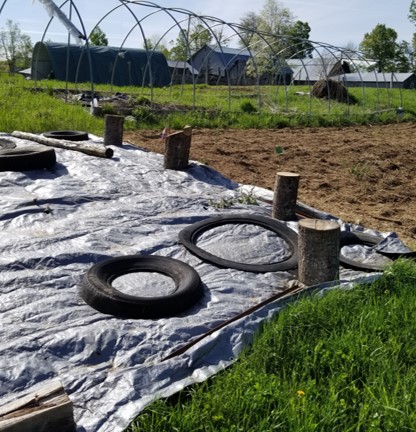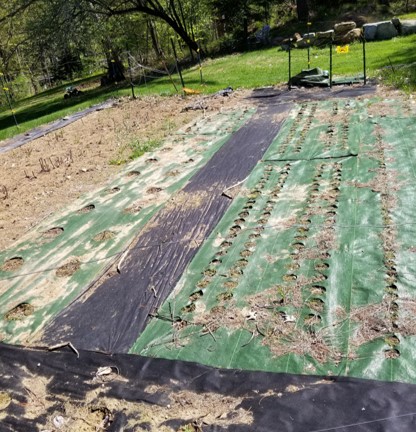Low and No-Till Gardening
For many gardeners, tilling the garden is as much a part of the spring gardening routine as fertilizing and planting. Gardeners come to rely on tillage to prepare a clean, fluffy seed bed, kill weeds, and simply turn the page. Tillage has other benefits too, including helping warm up the soil for planting, but increasingly gardeners are tuning in to some of the downsides of tillage and are exploring a new way of gardening with less tillage.
Mechanical Tillage
When gardeners think about tilling, rototilling often comes to mind first. Rototillers range in size, but for a garden setting are typically a gas-powered piece of equipment that is hand pushed and has wheels and uses blades to churn and break up soil. Mechanical tillage does have its place, especially in the formation of new garden beds with high compaction and low organic matter. In most cases, however, non-mechanical approaches to working with soil can help you accomplish your goals without negative effects on your soil.
If you are going to use mechanical tillage, such as a rototiller, you will want to avoid doing so when the soil is wet. For gardeners that are used to rototilling in the early spring, this is a common mistake that can compound problems of tillage. If you rototill before the soil has dried slightly from winter, the soil will be compacted once it does dry. Soil is dry enough to rototill so long as it does not stick to your shovel and shoes, and crumbles when squeezed. If you are going to use mechanical tillage, it should be done sparingly and should be used as an opportunity to incorporate organic matter like compost or manure and slow-release granular fertilizer.
Tillage and Soil Health
There are three types of soil health indicators, sometimes referred to as the three-legged stool of soil health:
- The physical structure, or “house”, of the soil. The physical structure of the soil affects drainage and retention of water, soil erosion, surface crusting and more.
- The biological properties refer to life in the soil, from earthworms to bacteria to fungi. These organisms form a food web that decomposes organic matter and releases nutrients in the process.
- The chemical properties of the soil are macronutrients (Nitrogen, Phosphorus and Potassium) and micronutrients, pH and more.
Tillage of the soil, especially deep tillage, weakens and disrupts both the physical and biological properties of the soil. Tillage weakens the soil’s microbial community that metabolizes and holds nutrients, sequesters and holds carbon, and absorbs and holds water. This can mean reducing the soil’s water holding capacity, promoting surface crusting, increasing erosion potential, and speeding up the loss of organic matter through accelerated decomposition. Tilled soil is still bacterial rich, but un-tilled garden soil is also rich in fungi. Fungi helps your plants become more productive, and your garden will be more productive without disrupting the fungal community within your garden’s soil.
Low and No Till Gardening Techniques
When putting your garden to bed in the fall, a critical aspect of no and low till gardening is to cut your plants at the soil line rather than pulling them out by the roots. Over the course of the winter and spring, those roots will decompose and add organic matter to the soil. You still want to remove aboveground plant material as part of an Integrated Pest Management approach to reduce insect and disease issues, but the roots can and should stay in the ground. In the spring, whatever is left of the stem can be plucked out.
In the spring, use a broad fork to alleviate compaction, incorporate soil amendments and prepare the bed for planting.
If you planted a cover crop in the summer or fall and it was winter killed, you should be able to peel apart the dead material to slip in your transplants. Do regular soil testing and produce your own compost to incorporate into your beds in the spring and fall.

Soil coverage is a key concept with no and low till gardening. At all times of year, your garden should either have mulched crops, a cover crop, or at least a layer of mulch on top. That mulch can be compost, straw, grass clippings, chopped leaves, or any other suitable organic material available to you. If using an organic mulch instead of cover crops in the fall, it should be left in place over the winter. In the spring, you can peel it away and plant into it. If using compost as a mulch, it can be incorporated in the spring with your broad fork.
If you can utilize cover crops when not growing crops, it’s worth considering because the living root of your cover crops benefits the soil and the biomass of the cover crop becomes green manure when incorporated. The most common time to sow a garden cover crop is in the early fall, after the conclusion of the summer harvest of warm season crops. However, time is of the essence because cover crops need time to germinate and get established before winter, so most cover crops need to be in the ground by mid-September at the latest. Some gardeners may also choose to grow a summer cover crop in between spring and early fall plantings of cool season crops. To incorporate cover crops, plan to group early season crops together that can be replaced with a cover crop, and group warm season crops together that can be replaced with another cover crop.
Yet another option is growing a cover crop within your summer plantings – oats, for example, can be seeded in the early fall even while you’re still harvesting your summer crops from the garden. By the time you harvest your last vegetables and cut your plants to the ground, your cover crop should already be established. Adjust your irrigation practices accordingly.
- Oats can be sown individually, or as part of a mix with field peas. Oats are a quick growing cool season annual grass that provides ample carbon while providing typical cover crop benefits such as weed suppression, Nitrogen scavenging, erosion control and soil softening. Peas are a legume that fix nitrogen in the soil. Both of these cover crops are winter killed in New Hampshire and are ideally planted in late summer or early fall. Oats will break down quickly and leave minimal residue for your spring planting. Peas will leave more residue, which can be incorporated or used as mulch for transplants. Growing a grass and legume together, like peas and oats, can amplify their benefits.
- Buckwheat is a popular cover crop because it can be squeezed in over the summer in between spring and fall crops. Plant buckwheat in the early summer where the garden that will be bare for 6 to 7 weeks. While buckwheat doesn’t introduce a lot of carbon into the system, it provides a nice, pollinator friendly cover that suppresses annual weeds and conserves moisture. Buckwheat will require termination before it goes to seed, which can be done with a string trimmer or a mower with its deck raised all the way up. Mow or cut down buckwheat within a week and a half of its first flowering.
- Tillage radish, which are often a cultivar of the Daikon variety, is another good option for gardeners, providing a good source of carbon, suppressing weeds and scavenging for Nitrogen in the fall while helping break up compacted soil with its deep root system. Seeding rate is important with tillage radish because if you seed too densely, the taproots will not grow to the size and depth you may be looking for, reducing the crop's "bio-tillage" benefits. Keep in mind that tillage radish is a brassica, so it can attract brassica pests and add another consideration for rotating crops in your garden.
- Winter rye is a popular choice because it can be seeded later in the fall than these other options, and it creates significant biomass. The downside is that it overwinters, and thus needs to be mowed when it starts to go to seed in the spring to terminate. It can also be tilled in, but if you’re aiming for a no-till garden you would want to mow with a brush or flail mower instead.
Weed control
One of the primary reasons people till is to control weeds, but while tillage does kill weeds at the surface it also brings weed seeds to the surface where they can germinate. Many weed seeds can remain viable in the soil for many years, and your tillage may bring up weeds you’ve never seen before that have been buried for years.
To prepare a new garden bed, smothering the weeds with black plastic, cardboard, silage tarps, or even billboard tarps is a good option. Ideally you smother for an entire year, but several months at a minimum.

Sheet mulching, also known as lasagna composting, is another technique that can be used to covert grass to garden beds, create border beds, and improve soil at the same time.

Once you have an established garden, always keeping the soil covered is key. Whether you use cover crops or mulch, use something to keep the soil covered at all times. Tarping is also an option for soil coverage over the winter or before planting in the spring.

Garden mats are also worthy of consideration. Garden mats are heavy-duty vegetable fabric that help control weeds and erosion, with pre-made holes for planting vegetables. Garden mats should not be left in the garden over winter.

When you do have weeds, and you always will, use a tool like a stirrup hoe to efficiently control them. Of course, weeding by hand will always be a good option, and there are countless tools to aid your weeding efforts.
Tools for Low and No Till Gardening
One aspect of reducing tillage is to use different tools that reduce disturbance of the soil and have a lower risk of compacting the soil.
One of the best tools to use is a broadfork. This tool features tines on a toolbar with a handle, and is used by stepping or even jumping on the toolbar and rocking back and forth. Unlike with tillage, broadforking does not invert the soil, but it does break through compaction.
A wheelhoe that is designed to go no deeper than 3 inches is another good alternative, especially for weed control.
Finally, the use of a rake is helpful for preparing seed beds, although direct seeding may still benefit from tillage. If you’re transplanting seedlings into your beds, tillage should not be necessary. Instead of tilling your entire garden, you may just till sections where you will be direct seeding, if necessary at all.
If you’re willing to invest, you might consider a tool called a tilther. This would be something for a market gardener or serious gardening enthusiast to consider. Tilthers help suppress weeds without disrupting the soil, and also effectively incorporate compost and other amendments into the soil while chopping up the roots of the previous crop – all without tillage.
If you’re incorporating cover crops, a helpful tool is a flail or brush mower. A traditional lawn mower will likely not be an appropriate tool for terminating a cover crop, so keep this in mind if you choose to grow a cover crop like winter rye that is not winter-killed in New Hampshire.
Olivia Saunders on Granite State Gardening
Olivia Saunders joined Granite State Gardening on July 30 to talk about low and no-till gardening in New Hampshire. You can watch the full interview below. This article summarizes and expands upon key topics covered in the interview.
Resources
Cover Cropping for Success by University of Maine Cooperative Extension
Cover Crops and Green Manures in Home Gardens by University of Minnesota Extension
Preparing a Vegetable Garden Site by UNH Extension
Sheet Mulching by Oregon State Extension
Got questions? The Ask UNH Extension Infoline offers practical help finding answers for your home, yard, and garden questions. Call toll free at 1-877-398-4769, Monday to Friday, 9 a.m. to 2 p.m., or e-mail us at answers@unh.edu.

